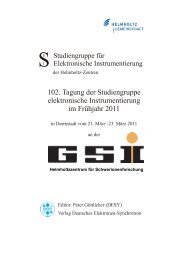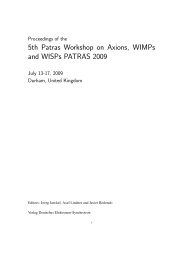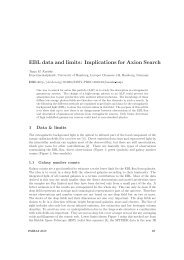Hamburg Neutrinos from Supernova Explosions ... - DESY Library
Hamburg Neutrinos from Supernova Explosions ... - DESY Library
Hamburg Neutrinos from Supernova Explosions ... - DESY Library
Create successful ePaper yourself
Turn your PDF publications into a flip-book with our unique Google optimized e-Paper software.
ely on the correlations between these supernovae and regions of massive star formation (giant<br />
HII regions) in galaxies, or estimating the ejected mass by modeling light curves and ejection<br />
velocities. Because of the nearness of SN1987A (a type II pec at ∼ 48 kpc) it was possible<br />
for the first time to identify the progenitor (a blue supergiant of mass ∼ 18 M⊙). In addition,<br />
the detection of a total of 19 neutrinos in the Kamioka and IMB detectors confirmed the basic<br />
CCSN scenario, namely, that a core collapse of a massive star does indeed occur, and that the<br />
bulk of the gravitational binding energy is radiated away by neutrinos. It was also possible to<br />
detect the progenitor for the next nearest explosion, SN1993 in M81 (∼ 3.6 Mpc), a type II<br />
which transformed to a type Ib, the data being best fit by a star of 15 M⊙ main-sequence (MS)<br />
mass and tidally stripped of most of its hydrogen envelope by prior binary mass transfer.<br />
The detection of other supernova progenitors has been made possible by high resolution<br />
archives of galaxy images built up over the past 15 or so years, mainly by the Hubble Space<br />
Telescope. By finding an image or an upper limit to an image on a high resolution pre-explosion<br />
galaxy image at the position of the SN it is possible, by comparing the color and magnitude<br />
of the image (or upper limit) with stellar models, to estimate the MS mass (or upper limit)<br />
and stellar type of the progenitor. For the progenitors of type II-P SNe, the most common<br />
type, this technique has netted 8 identifications (all red supergiants (RSGs), as expected) for<br />
which mass estimates are possible, and 12 upper limits (see [2] for a review through early<br />
2009). Surprisingly, within the uncertainties of stellar modeling and the possible extinction<br />
of the progenitor by dust, no progenitor of a SN II-P greater than 21 M⊙ has been found,<br />
and this upper limit is probably smaller. The lower limit appears to be about 8.5 M⊙. Two<br />
progenitors of SNe II-L have been identified (tentatively) as yellow supergiants (YSGs) with<br />
inferred progenitor masses of 18 - 25 M⊙, and only one progenitor of a SN IIn, a massive (≥<br />
50 M⊙) luminous blue variable (LBV). Several Type IIb SN progenitors have been identified;<br />
SN1993 mentioned above, and SN 2011dh whose progenitor has been identified as YSG of initial<br />
MS mass of 18–21 M⊙ [3] or 13 ± 3 M⊙ [4]. Unlike the above SN types, no progenitors of SNe<br />
Ib or Ic have been identified. They are expected to arise <strong>from</strong> Wolf-Rayet stars and/or <strong>from</strong><br />
stars whose H or H/He envelope has been tidally stripped by Roche lobe overflow to a binary<br />
companion. Their correlation with regions of massive star formation suggest that at least some<br />
arise <strong>from</strong> the former.<br />
It thus appears <strong>from</strong> observations that single stars in the MS mass range <strong>from</strong> ∼ 8.5 to 16<br />
- 21 M⊙ explode as SN II-P, and perhaps a subset of stars in this mass range that are tidally<br />
stripped in binaries and more massive single WR stars explode as SNe IIb, SNe Ib or Ic. On<br />
the basis of very limited observations, more massive stars explode as SN II-P when YSG’s, and<br />
very massive LBV explode as SN IIn. Unanswered are the fate of RSG more massive than ∼<br />
21 M⊙, whether some stars collapse directly to black holes with little or no optical display,<br />
whether there are distinct faint and bright branches of SN <strong>from</strong> a given mass range, and so on.<br />
1.2 Modeling<br />
STEPHEN W. BRUENN, ERIC J. LENTZ, ERIC J. LINGERFELT, ANTHONY . . .<br />
The evolutions of massive stars <strong>from</strong> the main-sequence (MS) to the onset of core collapse have<br />
been computed in 1D by a number of groups ([5] and references therein). These calculations<br />
have all shown the development of a generic stellar structure consisting of nested burning shells<br />
of successively heavier elements <strong>from</strong> the hydrogen-helium envelope on the outside to the siliconlike<br />
shell overlying an inert iron-like core at the center. One of the great uncertainties attending<br />
1D progenitor calculations is the modeling of turbulent mixing processes—e.g., turbulent mixing<br />
associated with thermal convection and/or rotational shear. Standard procedure is to use<br />
42 HAνSE 2011








